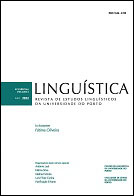Visualization of the relative relevance of researchers based on their textual production
Abstract
Building a researchers affinity network through the automatic processing of their publications allows us to gain a perspective that goes beyond the networks established through co-authorship. The definition of the importance of each researcher is defined upon their bibliographic production volume, i.e., number of publications, and also upon their centrality in the general network of researchers. In fact, the centrality of a researcher in a network reveals its importance in communication flows with other researchers, thus assuming that communication between researchers is itself a relevant factor for organizational life and in its production. Both network and centrality concepts are better interpreted in a graphical way. In this study, we explore the workflow that will provide these visualizations and focus in the empirical selection of the most appropriate centrality measure. We also propose a centrality visualization method that facilitates the interpretation of the selected measures.
References
AffinityMiner. (2015). Affinity Miner Online Prototype [Software]. http://affinityminer.com/
Brazdil, P., Trigo, L., Cordeiro, J., Sarmento, R., & Valizadeh, M. (2015). Affinity mining of documents sets via network analysis, keywords and summaries. Oslo Studies in Language, 7(1), 183-207.
Feldman, R., & Sanger, J. (2007). The Text Mining Handbook: Advanced Approaches in Analyzing Unstructured Data. Cambridge University Press.
Lesot, M. & Rifqi, M. (2010). Order-Based Equivalence Degrees for Similarity and Distance Measures. In E. Hüllermeier, R. Kruse, F. Hoffmann (Eds.), Computational Intelligence for Knowledge-Based Systems Design. IPMU 2010. Lecture Notes in Computer Science (Vol. 6178, pp. 19-28). Springer.
Martinez, A., Brazdil, P, Sarmento, R., Trigo, L., Silva, F., & Bugla, S. (2017). Analysis of Publications of Academic Staff of FEP and Their Affinities, FEP working papers, 599, Faculdade de Economia da Universidade do Porto.
Massart, D. L., & Smeyers-verbeke, A. J. (2005). Practical Data Handling - Visual Presentation of Data by Means of Box Plots. LC- GC Europe, 18(4), 215-218.
Mihalcea, R. (2004). Graph-based Ranking Algorithms for Sentence Extraction, Applied to Text Summarization. In Proceedings of the ACL Interactive Poster and Demonstration Sessions (pp. 170-173). Association for Computational Linguistics.
Newson, R. (2002). Parameters behind “nonparametric” statistics: Kendall’s tau, Somers’ D and median differences. The Stata Journal, 2(1), 45-64.
Pons, P., & Latapy, M. (2005). Computing Communities in Large Networks Using Random Walks. In P. Yolum, T. Güngör, F. Gürgen, & Can Özturan (Eds.) Proceedings of the 20th International Conference on Computer and Information Sciences (pp. 284-293). Springer-Verlag.
Sari, Y., Stevenson, M., & Vlachos, A. (2018). Topic or style? Exploring the most useful features for authorship attribution. In Proceedings of the 27th International Conference on Computational Linguistics (pp. 343-353). Association for Computational Linguistics.
Trigo, L., Vita, M., Sarmento, R., & Brazdil, P. (2015). Retrieval, visualization and validation of affinities between documents. In A. Fred, J. L. G. Dietz, D. Aveiro, K. Liu, J. Filipe (Eds.). Proceedings of the 7th International Joint Conference on Knowledge Discovery, Knowledge Engineering and Knowledge Management (IC3K 2015) (Vol. 3, pp. 452-459). Springer.
Tuzzi, A. (2010). What to put in the bag? Comparing and contrasting procedures for text clustering. Italian Journal of Applied Statistics/Statistica Applicata, 22(1), 77-94.
Víta, M., Komenda, M., & Pokorná, A. (2015, September). Exploring medical curricula using social network analysis methods. In 2015 Federated Conference on Computer Science and Information Systems (FedCSIS) (pp. 297-302). IEEE.
Wasserman, S., & Faust, K. (1994). Social network analysis: methods and applications. Cambridge University Press.
Downloads
Published
Issue
Section
License
Copyright (c) 2022 Linguística: Revista de Estudos Linguísticos da Universidade do Porto

This work is licensed under a Creative Commons Attribution-NonCommercial 4.0 International License.



